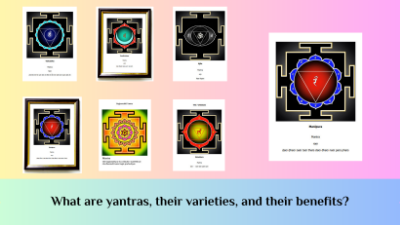
Yantras are geometric symbols or diagrams used in Buddhist and Hindu spiritual practices. They are regarded as holy and are thought to symbolize various facets of deities or divine energy. The Sanskrit words "yam," which means to control or harness, and "tra," which means an instrument or tool, are the roots of the word "yantra". Yantras are thought to be effective tools for spiritual development, meditation, and focus.
Yantras are generally composed of complex geometric designs, frequently encircled by squares or circles. They can be printed, engraved, or drawn on a variety of surfaces, including stone, metal, and paper. The geometric shapes in the diagrams—which include circles, triangles, and intersecting lines are thought to symbolize particular energies or deities.
Yantras are used in a variety of spiritual activities, such as worship, meditation, and reciting mantras. They are thought to serve as a concentration point and a channel for higher spiritual energies. Through focusing their attention on a yantra, practitioners seek to harmonize their consciousness with the specific energy or deity linked to the yantra.
Every yantra is connected to particular energies, deities, or intentions. One well-known yantra that symbolizes the divine feminine energy and is connected to the goddess Lalita Tripurasundari is the Sri Yantra. It is said that the Shri Yantra will bring wealth, success, and spiritual fulfillment.
Yantras are used with reverence and devotion as they are thought to be sacred. They frequently go together with mantras, which are sacrosanct utterances or chants. Reciting the matching mantra along with visualizing the yantra is thought to improve the practitioner's spiritual experience and strengthen their bond with the divine.
Different Types of Yantra at our store with Mantra
Available On Glossy Paper for Framing With Frame Or On Pocket Card
Vishuddha chakra yantra
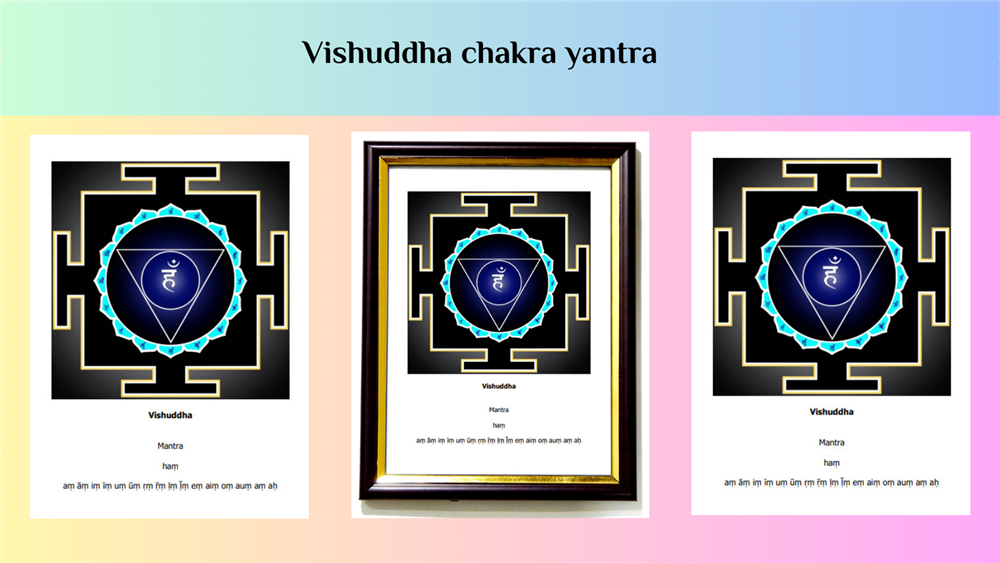
In Hinduism, the Vishuddha Yantra, which represents the throat chakra, is a powerful image. This chakra is connected to imagination, self-articulation, and communication.People who practice otherworldliness and the Vishuddha Yantra can work on their capacity to communicate their thoughts certainly and successfully in both individual and expert settings. Its intricate mathematical plan goes about as a visual instrument to assist with centering expectation and utilize this energy community's true capacity for self-improvement and change.
Swadhisthana chakra yantra
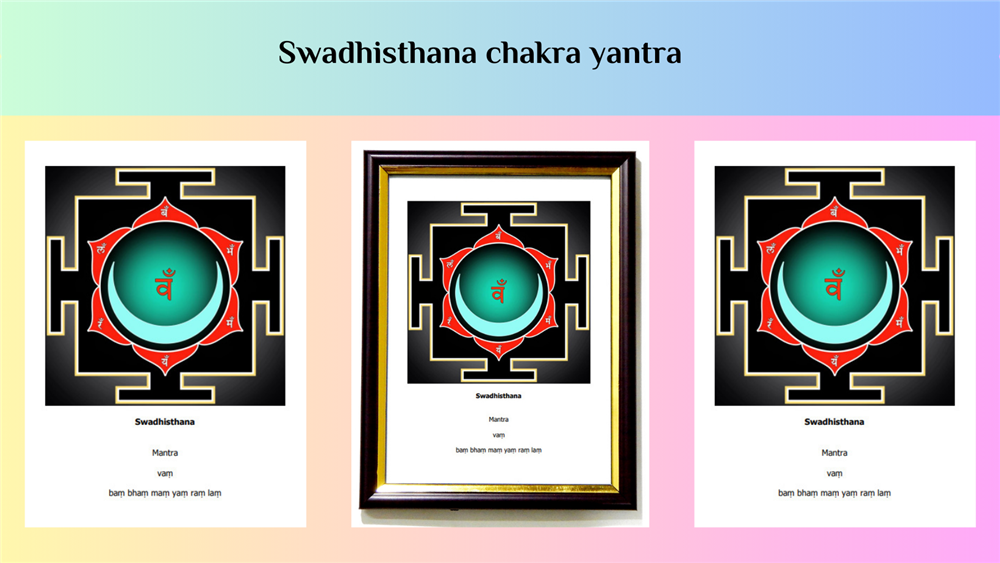
The Swadhisthana chakra yantra is a Hindu image used to adjust the sacral chakra, overseeing feelings, innovativeness, and sexuality. It highlights circles, triangles, and lotus petals, representing enthusiasm and essentialness. By contemplating this yantra, professionals can advance close to home soundness, exotic mindfulness, and imaginative motivation.
Anahata Yantra Chakra
.png)
The Anahata Yantra Chakra, otherwise called the Heart Chakra, is fundamental to cherish, empathy, and close to home equilibrium. It associates the lower and upper chakras, advancing compassion and self esteem. It's generally expected portrayed as a six-pointed star encompassed by lotus petals. Blending this chakra includes yoga, contemplation, variety, and inspiring pictures.
Ajna chakra yantra
.png)
The Ajna chakra yantra is an image of the 6th energy place, Shiva and Shakti, situated at the third eye. It supports reflection, advancing profound development and self-acknowledgment. The mathematical plan of the yantra joins Shiva and Shakti energies, upgrading instinct and navigation.
Manipura chakra yantra
.png)
The Manipura chakra yantra, a mathematical plan utilized in contemplation and yoga, addresses the sun oriented plexus chakra, representing individual power, self-assurance, and strength. It comprises of a ten-petal lotus bloom with a modified triangle, representing change. Zeroing in on this yantra can upgrade determination and confidence, enabling people to claim their own power.
Baglamukhi Yantra
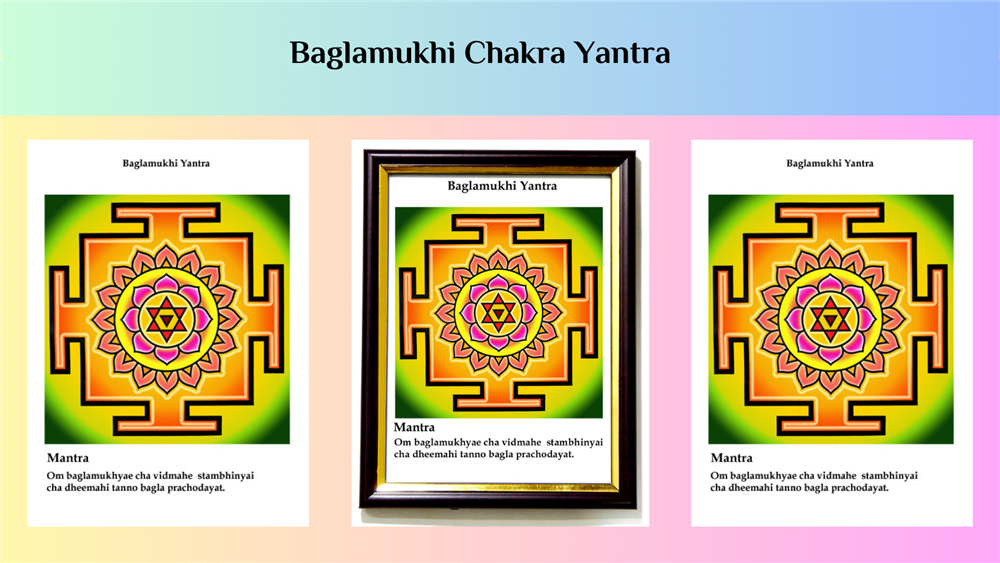
The Baglamukhi Yantra is a Hindu mathematical plan conjured by Goddess Baglamukhi to safeguard against pessimism and impediments. Its unpredictable examples represent divine energy and are utilized in ceremonies, supplications, and mantras for otherworldly development. The yellow tone represents information and flourishing, while its novel shape reflects astronomical energy. Embracing it brings equilibrium, boldness, and inspiration.
Muladhara Chakra Yantra
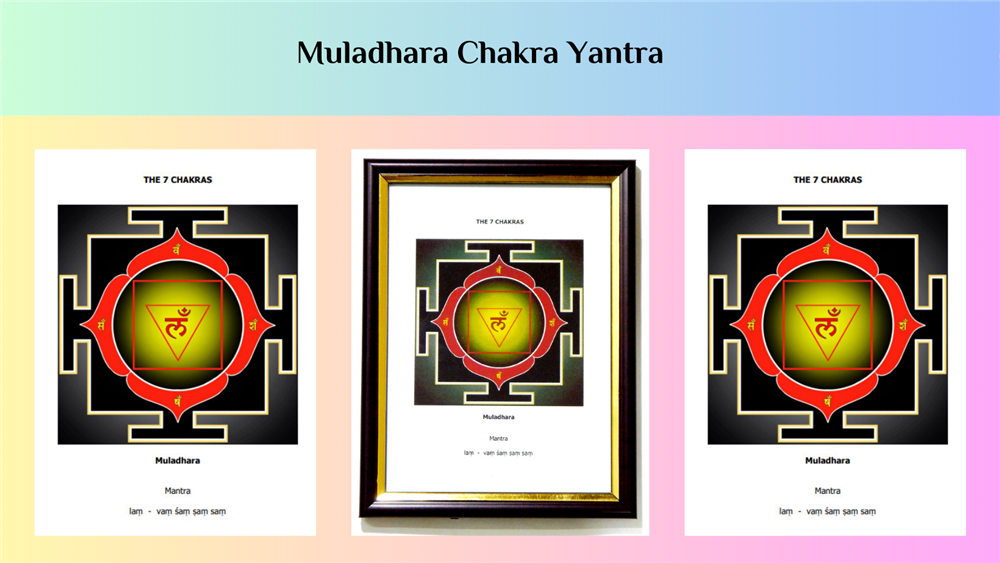
The Muladhara Chakra Yantra is a consecrated mathematical image addressing the root chakra, related with strength and basic senses. It includes a lotus bloom and four entryways addressing earth, water, fire, and air. Reflection on this image advances security, establishing, and association with one's feeling of direction, improving internal strength and versatility.
Types of yantra for love, health, wealth and Protection
There are various yantras associated with love, health, and wealth. Here are a few examples:
Kamadeva Yantra: Kamadeva is the Hindu god of love and desire. It is said that the Kamadeva Yantra attracts love, strengthens bonds, and encourages harmony between partners. It has the power to arouse feelings of passion and love.
Dhanvantari Yantra: In Hindu mythology, Dhanvantari is the god of healing and health. The Dhanvantari Yantra is linked to wellbeing, illness prevention, and good health. It can be used for healing and is thought to support both mental and physical health.
Kubera Yantra: The god of prosperity and wealth is called Kubera. Attracting wealth, abundance, and financial prosperity is linked to the Kubera Yantra. It is thought to bestow blessings for monetary prosperity and business success.
Sri Yantra: The Sri Yantra is a strong and generally respected yantra that addresses the heavenly female energy. Giving generally assurance and otherworldly upliftment is accepted. The complicated math of the Sri Yantra is said to make a defensive safeguard against adverse impacts and advance concordance and inspiration.
Durga Yantra: Maa Durga is a Hindu goddess known for her furious and defensive nature. The Durga Yantra is related with her energy and is accepted to offer insurance from insidious powers, adverse impacts, and deterrents. It can help in conquering difficulties, both physical and profound.
Sudarshan Chakra Yantra: The Sudarshan Chakra Yantra addresses the heavenly weapon of Master Vishnu, known as the Sudarshan Chakra. It is viewed as an integral asset for insurance, profound development, and eliminating snags. This yantra is accepted to kill negative energies and proposition in general prosperity and security.
Navagraha Yantra: The Navagraha Yantra is a yantra that addresses the nine divine bodies or planets in Vedic crystal gazing. It is utilized to adjust and blend the energies of the planets and safeguard against their adverse impacts. This yantra is accepted to achieve steadiness, achievement, and insurance from visionary hardships.
These are but a handful of the numerous yantras linked to various facets of wealth, health, and love.



